Module 9 Population Unit 3 Language in use 课件(共70张PPT,无音频)
文档属性
| 名称 | Module 9 Population Unit 3 Language in use 课件(共70张PPT,无音频) | 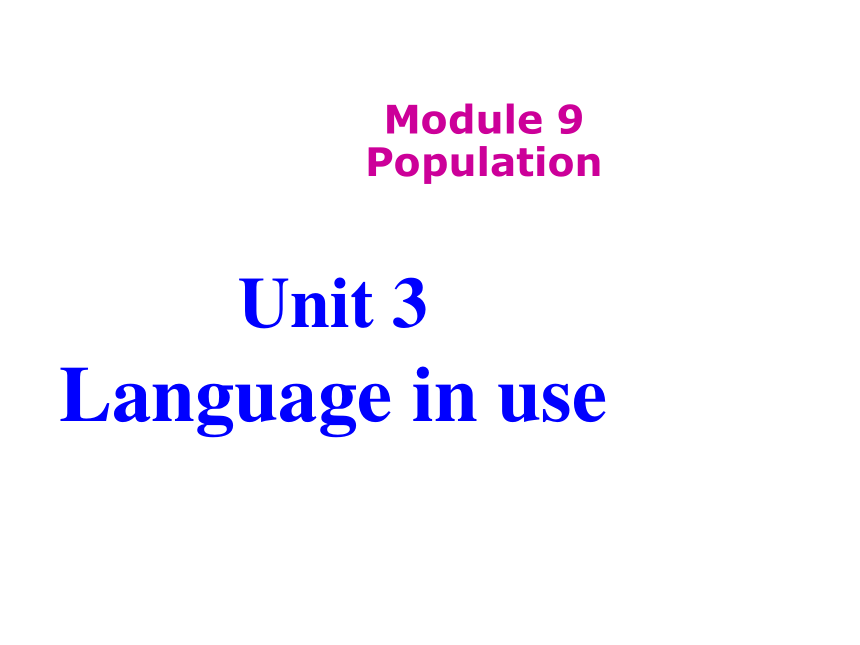 | |
| 格式 | zip | ||
| 文件大小 | 1.8MB | ||
| 资源类型 | 教案 | ||
| 版本资源 | 外研版 | ||
| 科目 | 英语 | ||
| 更新时间 | 2020-08-03 21:16:09 | ||
图片预览

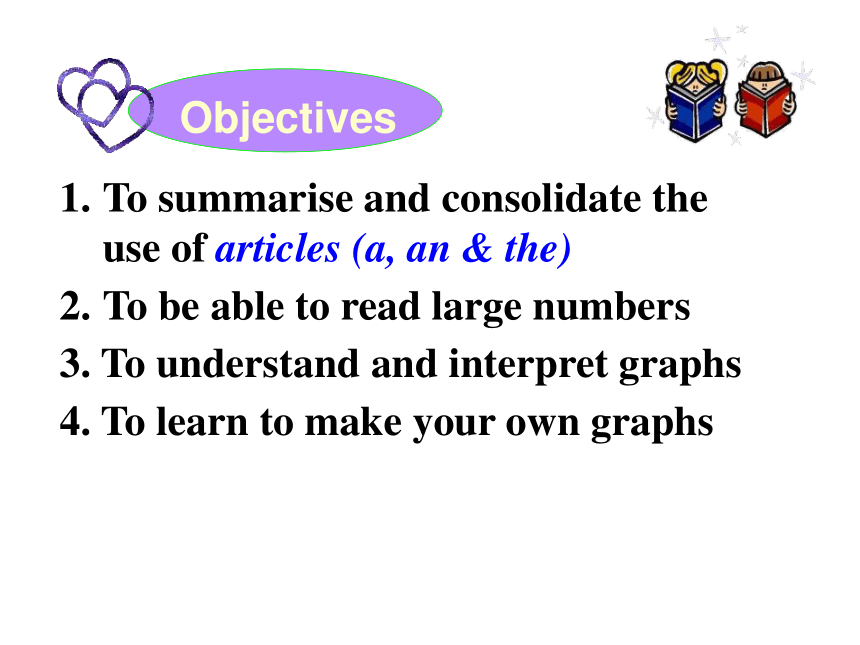
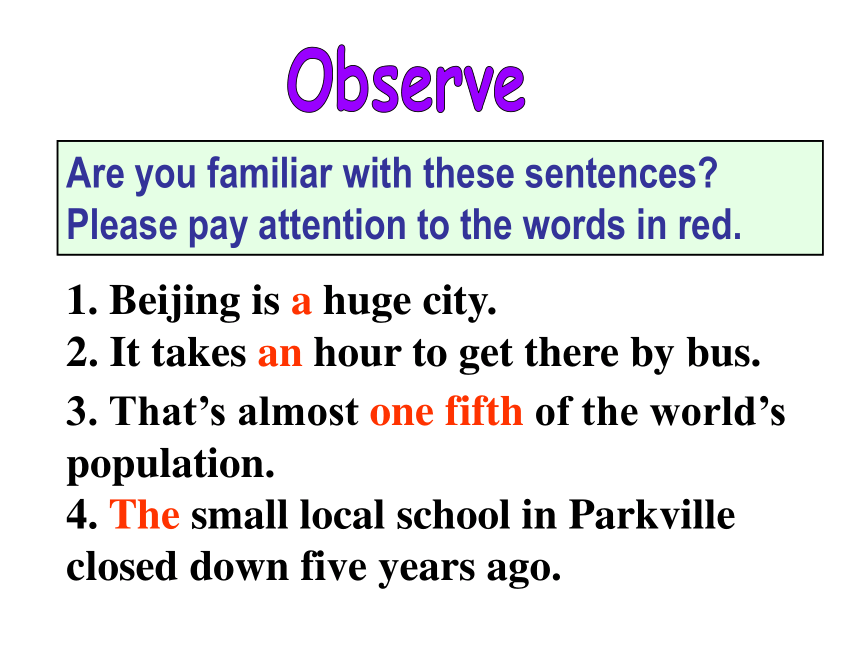
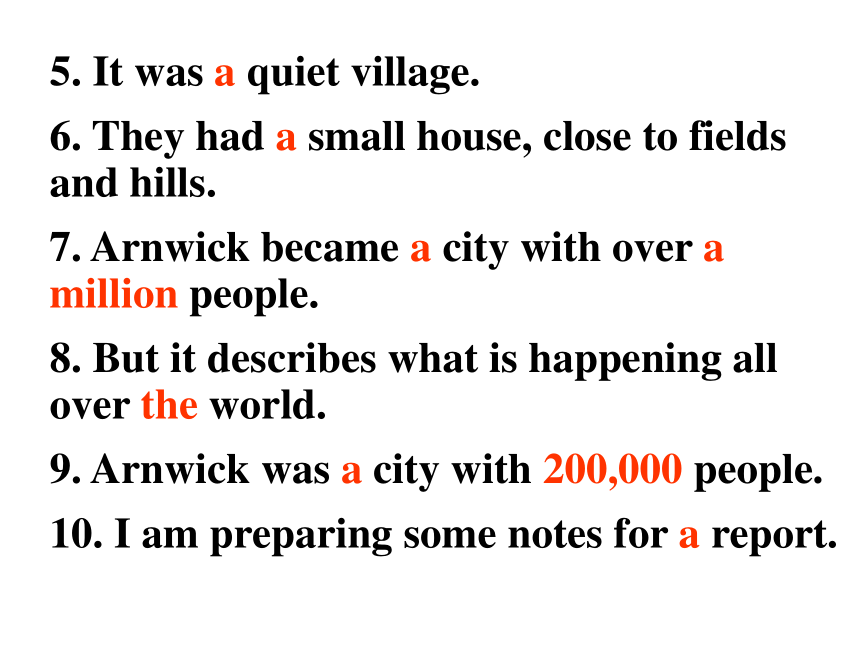
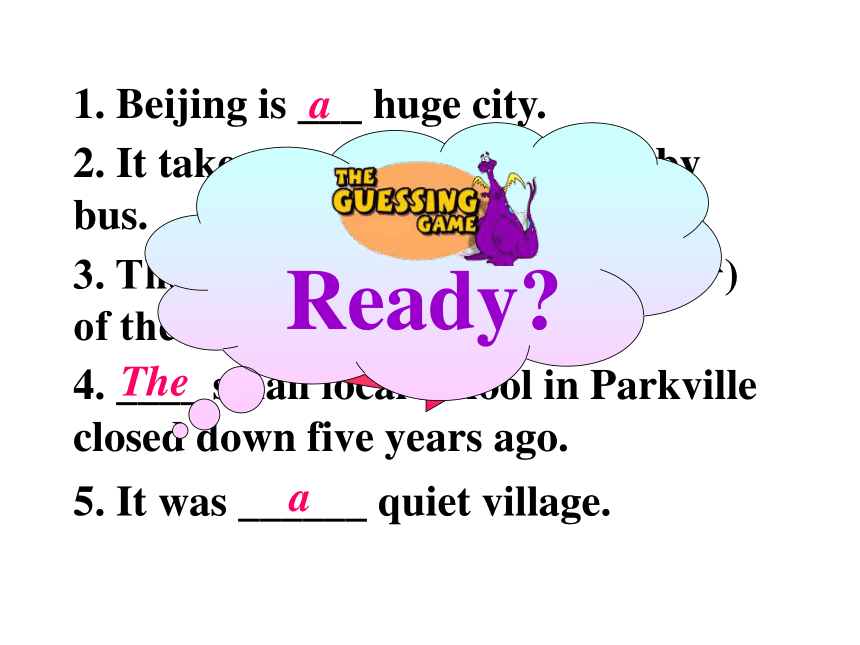
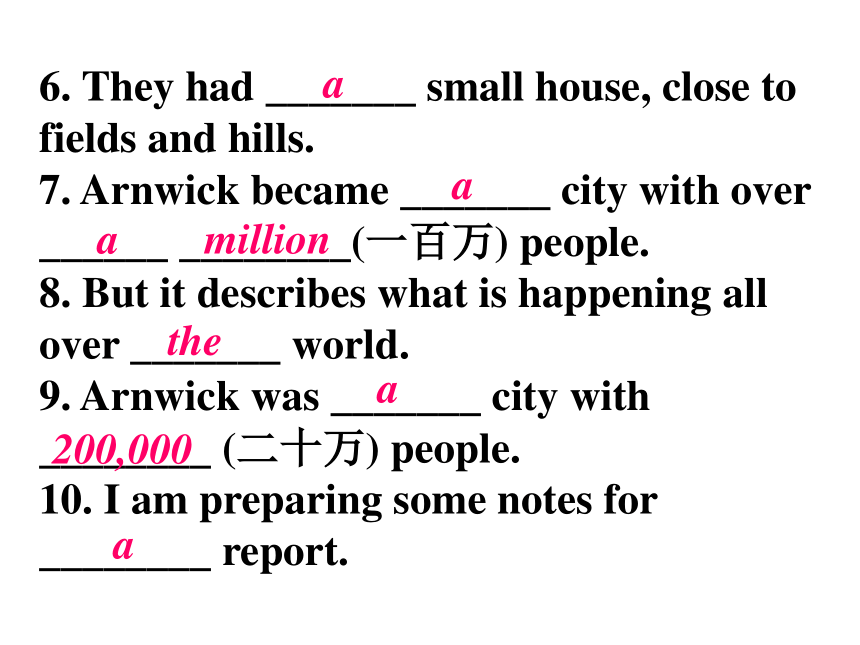

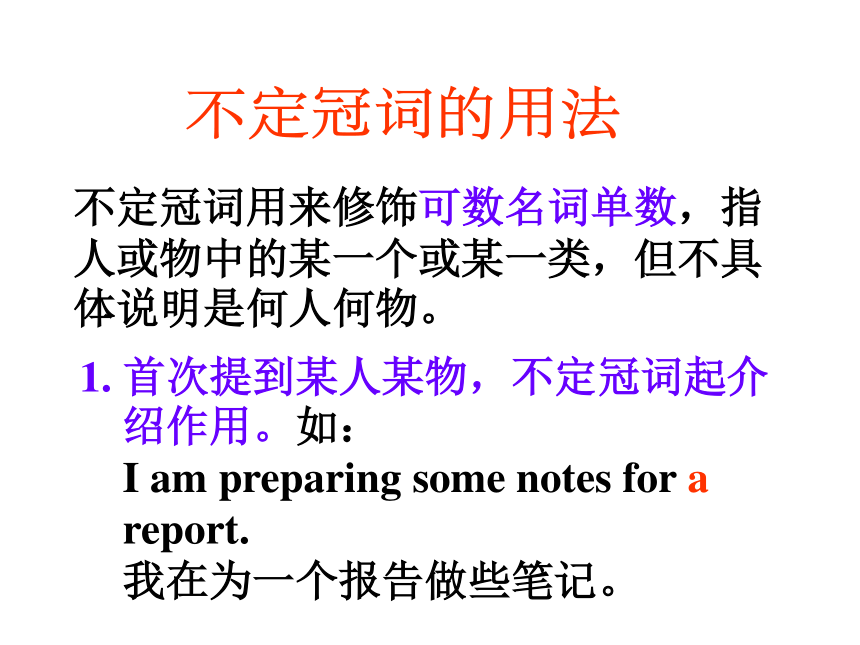
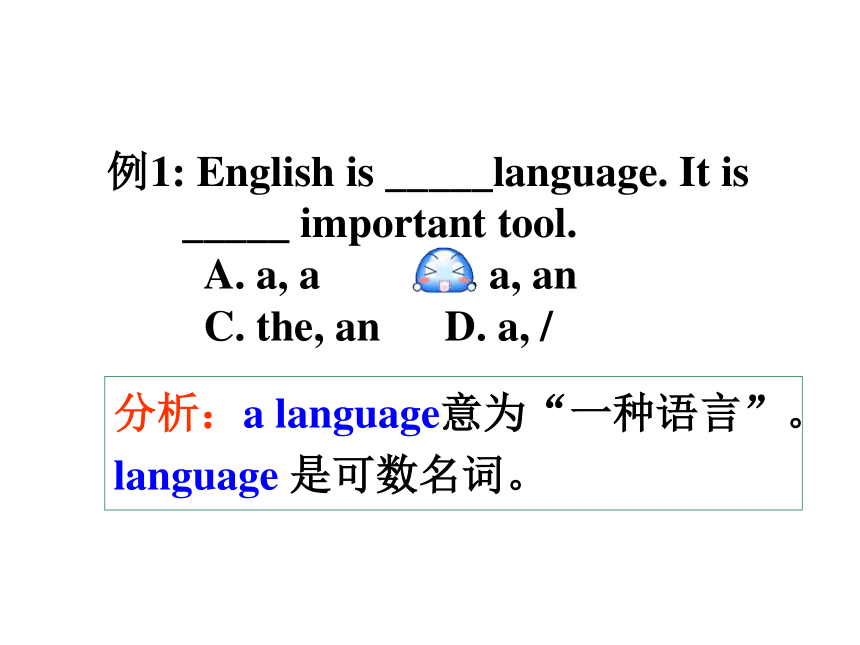
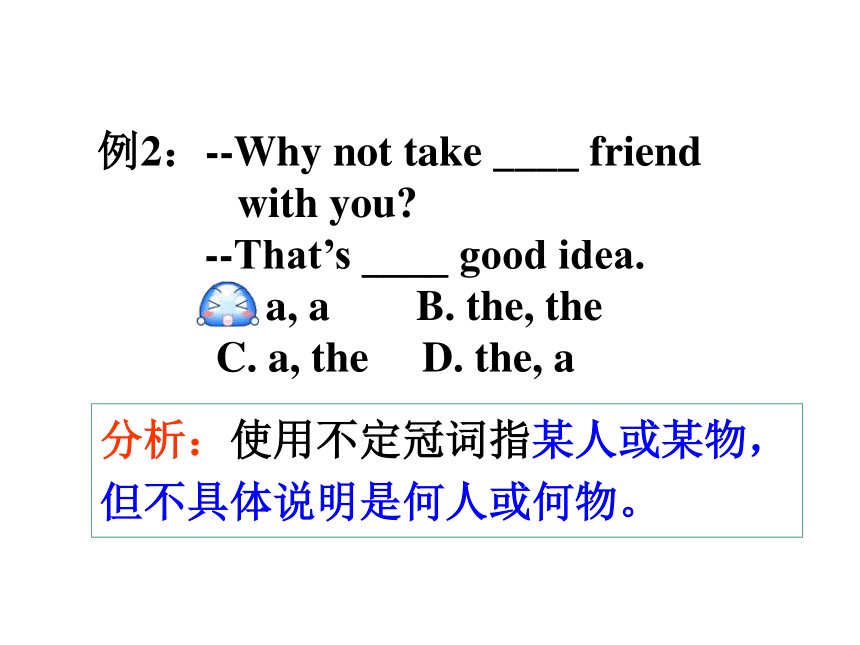
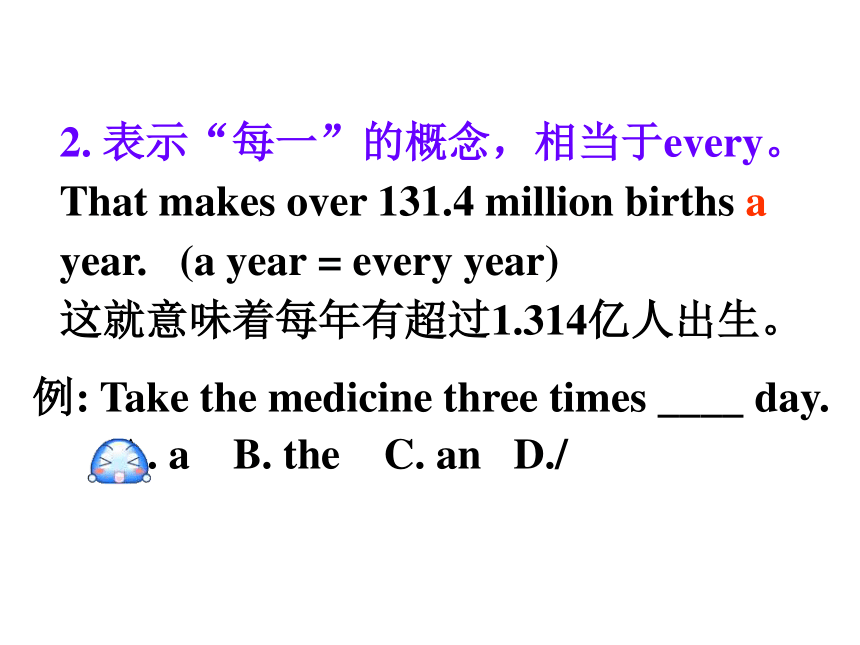

文档简介
(共70张PPT,无音频)
Unit
3
Language
in
use
Module
9
Population
To
summarise
and
consolidate
the
use
of
articles
(a,
an
&
the)
To
be
able
to
read
large
numbers
3.
To
understand
and
interpret
graphs
4.
To
learn
to
make
your
own
graphs
1.
Beijing
is
a
huge
city.
2.
It
takes
an
hour
to
get
there
by
bus.
3.
That’s
almost
one
fifth
of
the
world’s
population.
4.
The
small
local
school
in
Parkville
closed
down
five
years
ago.
Observe
Are
you
familiar
with
these
sentences?
Please
pay
attention
to
the
words
in
red.
5.
It
was
a
quiet
village.
6.
They
had
a
small
house,
close
to
fields
and
hills.
7.
Arnwick
became
a
city
with
over
a
million
people.
8.
But
it
describes
what
is
happening
all
over
the
world.
9.
Arnwick
was
a
city
with
200,000
people.
10.
I
am
preparing
some
notes
for
a
report.
1.
Beijing
is
___
huge
city.
2.
It
takes
___
hour
to
get
there
by
bus.
3.
That’s
almost
___
____(五分之一)
of
the
world’s
population.
4.
____
small
local
school
in
Parkville
closed
down
five
years
ago.
5.
It
was
______
quiet
village.
a
an
one
fifth
The
a
go
Ready?
6.
They
had
_______
small
house,
close
to
fields
and
hills.
7.
Arnwick
became
_______
city
with
over
______
________(一百万)
people.
8.
But
it
describes
what
is
happening
all
over
_______
world.
9.
Arnwick
was
_______
city
with
________
(二十万)
people.
10.
I
am
preparing
some
notes
for
________
report.
a
a
a
million
the
a
200,000
a
1.
冠词是虚词,是限定词的一种,不能单独使用,常用于修饰名词。
2.
冠词有两种形式:不定冠词
a/an,定冠词the。
在很多场合我们还会看到零冠词的提法,所谓零冠词就是不使用冠词。
Articles
冠词
不定冠词的用法
不定冠词用来修饰可数名词单数,指人或物中的某一个或某一类,但不具体说明是何人何物。
首次提到某人某物,不定冠词起介绍作用。如:
I
am
preparing
some
notes
for
a
report.
我在为一个报告做些笔记。
例1:
English
is
_____language.
It
is
_____
important
tool.
A.
a,
a
B.
a,
an
C.
the,
an
D.
a,
/
分析:a
language意为“一种语言”。language
是可数名词。
例2:--Why
not
take
____
friend
with
you?
--That’s
____
good
idea.
A.
a,
a
B.
the,
the
C.
a,
the
D.
the,
a
分析:使用不定冠词指某人或某物,但不具体说明是何人或何物。
2.
表示“每一”的概念,相当于every。
That
makes
over
131.4
million
births
a
year.
(a
year
=
every
year)
这就意味着每年有超过1.314亿人出生。
例:
Take
the
medicine
three
times
____
day.
A.
a
B.
the
C.
an
D./
例:
______
steel
worker
makes
steel.
A./
B.
A
C.
This
D.
That
分析:a
(an)放于单数的可数名词前表
示“一类”。该句中
a
steel
worker是指
钢铁工人们。表示一类有三种方式:
A
bike
is
slower
than
a
car.
The
bike
is
slower
than
the
car.
Bikes
are
slower
than
cars.
3.
用于可数名词单数形式之前,表示人或事物的类别。如:
My
mother
is
a
doctor.
我母亲是一位医生。
4.
某些固定短语中,要用不定冠词。如:
have
a
good
time,
in
a
hurry,
have
a
break,
a
lot
of,
have
a
look,
with
a
smile…
例1:Tom
has
____
high
fever
and
his
mother
is
looking
after
him.
A.
a
B.
the
C.
an
D./
分析:
表示生什么病前应用a,
例如:have
a
headache
/
have
a
cold。
例2:Mary
takes
____
walk
after
supper
every
day.
A.
the
B.
a
C.
/
D.
one
分析:
give,
take,
have与一些动词名
词化的词连用,表示一次动作,名
词前要加a。
have
a
talk
(bath,
look)
make
a
living
(promise)
take
a
swim
(walk,
rest)
give
a
talk
(whistle,
smile)
在使用不定冠词时要注意a与an的不同。a
用在辅音音素开头的单词前,如:a
city,
a
university
student;
an用在以元音音素开头的单词前,如:an
egg,an
old
man。
不定冠词a
&
an
注意:
元音音素开头的单词不一定是元音字母
(a,
e,
i,
o,
u)开头。
u
发音
[ju:]或[ju]时前面用冠词
a,u读[?]时前面用冠词an。
2.
26个字母中开头以元音音素发音的字母有:
f
[ef],
h
[eit?],
l
[el],
n
[en],
r
[a:],
s
[es],
x
[eks]
There
is
an
“R”
in
the
word.
This
is
a
European
country.
European词首字母不发音,
[j]是辅音音素。
This
is
a
one-eyed
dog.
one词首音素
[w]是辅音音素。
例:
There
is
____
“
f
”
and
____
“
u
”
in
the
word
“four”.
A.
an,
a
B.
a,
a
C.
an,
an
D.
a,
an
分析:在名词前使用a或an要取决于该名词的读音。如果首字母的读音是元音因素,应用an;如果首字母的读音是辅音音素,应用a。
指前文提到过的人或物,或特指某人或某物。
I
have
a
dog
and
a
cat.
The
dog
is
brown
and
the
cat
is
black.
The
old
man
with
thick
glasses
is
their
history
teacher.
2.
指谈话双方都知道的人或物。如:
I
had
to
write
the
report
twice
last
term!
上学期的报告我不得不写了两遍!
定冠词的用法
例1:
There
is
___bridge
over
the
river.
___
bridge
is
made
of
stone.
A.
a,
A
B.
a,
The
C.
the,
The
D.
the,
A
分析:
文章中第一次出现的可数名词
前用a(an)。下次再出现此名词则用the。
I
have
a
little
bird.
The
bird
is
yellow.
例2:
___
old
workers
under
that
tree
are
from
Shanghai.
A.
The
B.
An
C.
This
D.
That
分析:名词后有表示范围、地点的介词短语限定时,
名词前应加the来表示特指。
The
boys
here
are
interested
in
sports.
3.
用于序数词以及形容词的最高级之前。
China
has
the
largest
population
in
the
world,
and
India
has
the
second
largest
population.
中国是世界上人口最多的国家,印度其次。
例1:
____
first
one
sat
down
and
the
second
stood
up.
A.
The
B.
A
C.
One
D.
An
例2:
Winter
is
____
coldest
season
of
the
year.
A.
a
B.
the
C./
D.
so
例:
___
moon
moves
around
___
earth,
and
they
both
are
smaller
than
____
sun.
A.
The,
the,
the
B.
A,
an,
a
C.
The,
an,
the
D.
The,
the,
a
4.
用于指世界上独一无二的事物。如:
The
moon
is
far
smaller
than
the
earth.
月球比地球小得多。
例:
We
live
in
____
south
of
China.
A.
the
B./
C.
a
D.
some
分析:
表示东、南、西、北方的名词前要加the。
The
sun
rises
in
the
east.
5.
用于表示方位的名词前。如:
Shanghai
is
in
the
east
of
China.
上海位于中国的东部。
例:
The
small
town
lies
on
____Yangtzi
River.
A.
a
B.
an
C.
/
D.
the
6.
用于江河、海洋、山脉等地理名词及由普通名词构成的专有名词前。例如:
the
Nile,
the
Pacific
Ocean,
the
Alps,
the
Great
Wall
of
China
例:
He
will
go
to
see
you
off
at
___
Railway
Station.
A.
a
B.
an
C.
the
D.
/
分析:
the+普通名词构成专有名词。
例:
I
was
playing
____
piano
at
eight
yesterday
morning.
A.
a
B.
/
C.
the
D.
this
分析:
play+乐器表示弹奏时,该乐器名
词前加
the。
Alice
likes
to
play
the
violin
while
Kate
likes
to
play
the
flute.
7.
用在乐器名称的前面表弹奏。如:
Can
you
play
the
guitar?
你会弹吉他吗?
例:
___
young
should
care
for
and
help
___
old.
A.
The,
a
B.
The,
the
C.
A,
the
D.
An,
an
分析:
the+形容词(形容词名词化)
表示一类人或事物。
the
poor
/
the
rich
/
the
sick
/
the
beautiful
8.
在某些形容词前加定冠词,表示一类人或物。如:
She
devoted
her
life
to
helping
the
poor.
她毕生都在帮助穷人。
例:
____
browns
are
watching
TV
at
home
at
the
moment.
A.
/
B.
The
C.
Mr.
D.
A
9.
用于姓氏复数形式之前,表示“一家人”或“夫妇两人”。如:
The
Smiths
are
coming
to
visit
on
Saturday.
周六史密斯一家要来访。
10.
用于某些固定短语中。如:
in
the
morning,
the
day
after
tomorrow,
listen
to
the
radio,
at
the
moment,
go
to
the
beach,
by
the
way…
例1:
Last
night
we
went
to
____
cinema.
A.
the
B.
a
C.
/
D.
those
分析:
牢记一些固定搭配:
go
to
the
concert
(theatre)
例2:
Our
teacher
gets
up
early
in
____
morning.
A.
the
B.
/
C.
a
D.
an
分析:
牢记一些含the的习惯用语,在句中用作时间状语。
in
the
afternoon
(evening)/
in
the
daytime
at
the
beginning/in
the
end
例3:
There
is
a
large
ship
in
____
middle
of
the
river.
A.
a
B.
/
C.
the
D.
any
分析:
牢记一些含the的习惯用语,在句中用作地点状语。
on
the
right
(left)
/in
the
front
of…
in
the
middle
of
/
in
the
forest
/
at
the
foot
of
the
hill
零冠词的用法
名词前已有物主代词、指示代词、不定代词、所有格或数词等作定语,则其前面不再用冠词。如:
My
schoolbag
is
not
red.
我的书包不是红色的。
I
have
two
questions
to
ask.
我有两个问题要问。
例:
There
is
no
____
book
on
the
desk.
A.
the
B.
a
C.
an
D.
/
分析:
名词前有物主代词、指示代词、不定代词、名词所有格或any和no时,均不再用冠词。如:
no
books,
not
any
books
2.
在球类活动、棋类、学科名称和表三餐的名词前不用冠词。如:
The
little
girl
likes
playing
chess.
这个小姑娘喜欢下棋。
例1:
These
boys
play
____
football
after
class.
A.
a
B.
the
C.
that
D.
/
分析:
球类、棋类、游戏名称前不加冠词。
例2:
He
doesn’t
have
____
breakfast
at
home.
A.
a
B.
the
C.
this
D.
/
分析:
表示三餐的名词前不加冠词,如果前面有形容词修饰该词,表示“一顿……的饭”,可加a。
have
a
big
supper
(nice
lunch)
3.
在表示洲名、国名、人名以及专有地名的名词前不加冠词。如:
Asia
is
the
largest
continent
in
the
world.
亚洲是世界上最大的洲。
例1:
They
often
take
a
walk
in
____
Hyde
Park.
A.
the
B.
a
C.
/
D.
this
分析:
在一些专有地名之前不加冠词。
如:Wall
Street
例2:
I
studies
___English
in___
England.
A.
/,
/
B.
an,
the
C.
an,
an
D.
/,
the
分析:
学科前和国名、洲名前一般不加冠词。
learn
Chinese
(maths,
physics,
chemistry)
China
is
in
Asia.
in
Germany
(Japan)
in
Africa
(Europe
…)
4.
在节假日、星期、季节、月份等名词前不加冠词。如:
Women’s
Day
is
on
March
8th.
妇女节是3月8日。
例
1:
We
have
no
classes
on
____
Sundays.
A.
the
B.
these
C.
/
D.
those
例2:
____
January
is
the
first
month
of
the
year.
A.
The
B.
A
C.
/
D.
That
分析:
表示节日、月份的名词前一般
不加the。Spring
is
coming.
He
was
born
in
December.
如果表示有某年限定的季节和月份时,季节和月份前要加
the。
He
was
born
in
the
summer
of
1964.
例:
____
running
is
good.
A.
The
B.
A
C.
/
D.
An
5.
V-ing形式前一般不用冠词。
Walking
on
the
moon
is
difficult.
在月球上行走是十分困难的。
Seeing
is
believing.
眼见为实。
例:
We
go
to
work
by
__
bus.
A.
/
B.
a
C.
the
D.
one
6.
表示交通工具的手段时,用“by+名词”表示,该名词前不用冠词。如:
by
bike
(taxi,
car,
train,
plane,
spaceship)或by
sea
(water,
air,
land)
例:
The
students
of
____
Grade
One
are
having
a
meeting.
A.
these
B.
/
C.
a
D.
an
7.
名词+数词表示顺序时,前面不加冠词
the;序数词+名词表示顺序数,序数词前加冠词the。
turn
to
page
3
/
the
third
page
Lesson
One
/
the
first
lesson
gate
Five
/
the
fifth
Gate
例:
He
often
works
late
at
____
night.
A.
/
B.
the
C.
a
D.
all
8.
表示时间或地点的一些“介词+名词”的词组和一些固定词组中,均不加冠词。如:
at
home,
in
town,
at
noon,
at
daybreak,
in
trouble,
in
danger,
in
fact等。
注意:
有些名词前用冠词或不用冠词,其意义有所不同。如:
1)
at
table
在吃饭
at
the
table
在桌子旁
2)
in
class
在上课
in
the
class
在班级中
3)
go
to
school
去上学
go
to
the
school
到那所学校去
4)
go
to
bed
上床睡觉
go
to
the
bed
到床那边去
5)
in
front
of
在…的前面
in
the
front
of
在…的前部
首次提到某人某物,不定冠词起介绍
作用。
2.
表示“每一”的概念,相当于every。
3.
用于可数名词单数形式之前,表示人或事物的类别。
4.
某些固定短语中,要用不定冠词。
不定冠词的用法
Summary
指前文提到过的人或物,或特指某
人或某物。
2.
指谈话双方都知道的人或物。
3.
用于序数词以及形容词的最高级之前。
4.
用于指世界上独一无二的事物。
5.
用于表示方位的名词前。
定冠词的用法
6.
在江河、海洋、山脉等地理名词前及由普通名词构成的专有名词前。
7.
用在乐器名称的前面表弹奏。
8.
在某些形容词前加定冠词,表示一类人或物。
9.
用于姓氏复数形式之前,表示“一家人”或“夫妇两人”。
10.
用于某些固定短语中。
1.
名词前已有物主代词、指示代词、不定代词、所有格或数词等作定语,则其前面不再用冠词。
2.
在球类活动、棋类、学科名称和三餐的名词前不用冠词。
3.
在表示洲名、国名、人名以及专有地名的名词前不加冠词。
4.
在节假日、星期、季节、月份等名词前不加冠词。
零冠词的用法
5.
V-ing形式前一般不用冠词。
6.
表示交通工具的手段时,用“by+名词”
表示,该名词前不用冠词。
7.
名词+数词表示顺序时,前面不加冠
词
the;序数词+名词表示顺序数,
序数词前加冠词the。
8.
表示时间或地点的一些“介词+名词”的词组和一些固定词组中,均不加冠词。
用“基数词+序数词”表示,其中基数词表示分子,序数词表示分母。分子除用one外,也可用a;如果分子大于1,分母要用复数形式。
英语分数的表示法
Two
thirds
of
the
students
have
passed
the
exam.?
三分之二的学生考试及格了。
注意:1/2不能说a
(one)
second,而要说a
(one)
half。
1/4
和
3/4可以说
a
(one)
fourth
和three
fourths,但常用
a
quarter和
three
quarters表示。
若它们在句子中作主语,则谓语动词是用单数还是复数取决于名词,即与分数所修饰的名词保持一致。
About
two
thirds
of
the
students
attend
the
meeting.
大约2/3的学生都参加了会议。
在英语中,对于万以上的数字,我们该如何表达呢?这就要记住英语数字读法特点。以下面一个数字为例:
6,500,431,729
hundred
thousand
million
billion
注意每三个数为一个单位,按照百、
十、个向下读。
大数字的表达方法
6,500,431,729
seven
hundred
and
twenty-nine
thousand
million
billion
six
billion,
five
hundred
million,
four
hundred
and
thirty-one
thousand,
hundred
Work
in
pairs.
Match
the
countries
with
their
populations.
China
the
US
Australia
New
Zealand
4,437,000
22,956,000
314,791,000
1,370,537,000
Read
your
answers
to
the
whole
class.
China
has
a
population
of…
Now
listen
and
check.
1
2
P76
P76
Read
the
chart
and
answer
the
questions.
3
P76
1.
Which
city
had
the
largest
population
in
2000?
Tokyo
had
the
largest
population
in
2000.
2.
Which
city’s
population
will
increase
the
most
from
2000
to
2025?
Mumbai’s
population
will
increase
the
most
from
2000
to
2025.
Mexico
City
will
have
a
larger
increase
in
its
population.
3.
Which
city
will
have
a
larger
increase
in
its
population,
New
York
or
Mexico
City?
4.
Which
city
/
cities
do
you
think
will
have
the
biggest
population
problem?
Why?
I
think
Mumbai
will
have
the
biggest
population
problem
because
its
population
will
increase
the
fastest.
Mina
is
(1)____
eighteen-year-old
girl.
She
has
got
(2)___
brother
and
(3)___
sister.
Mina
is
(4)____
oldest
child
in
(5)___
family.
She
lives
in
(6)
___
very
big
city.
She
has
(7)____
job
in
(8)
___
hotel.
She
hopes
that
one
day
she
will
have
(9)
____chance
to
go
to
(10)____
college.
Complete
the
passage,
with
a,
an
or
the
where
necessary.
an
a
a
the
the
a
a
a
a
/
4
P77
1.
We
believe
the
schools
in
Arnwick
are
very
good,
and
we
are
working
to
make
them
even
______.
2.
Their
flat
is
too
large
for
two
people.
They
want
to
find
a
______
one.
3.
Anna
always
talks
about
her
ideas.
I
think
she
needs
to
listen
______.
4.
There
are
a
lot
of
parks
in
this
city.
I
think
there
are
_______
parks
in
a
lot
of
other
cities.
smaller
more
fewer
few
good
much
small
better
Complete
the
sentences
with
the
correct
form
of
the
words
in
the
box.
5
P77
air
city
countryside
hospital
increase
public
service
traffic
water
the
countryside/
Parkville
the
city
increases
air
pollution
water
pollution
too
much
traffic
rubbish
(crowded
flat)
not
enough
hospitals
need
more
schools
and
buses
need
better
public
services
need
more
police
to
protect
people
Complete
the
diagram
showing
population
problems.
Use
the
words
in
the
box
to
help
you.
6
P77
Our
world
is
facing
many
problems.
Two
of
the
biggest
are
increasing
population
and
pollution.
The
(1)__________
of
the
world
is
increasing
quickly.
Why
is
this
happening?
Because
more
babies
are
born
every
year
and
people
also
live
longer.
Many
people
are
leaving
the
(2)___________
to
work
in
the
cities,
but
there
is
not
enough
(3)
_______
for
so
many
people.
Another
huge
problem
for
the
world
is
(4)_________.
There
is
so
much
(5)
______
on
the
road
that
in
some
cities
the
air
is
heavily
polluted.
We
should
work
harder
to
protect
our
world.
population
space
countryside
countryside
pollution
population
space
traffic
pollution
traffic
Complete
the
passage
with
the
words
in
the
box.
7
P78
1.
Growing
population
is
a
problem
______
_______________.
2.
The
population
of
China
may
grow
more
slowly
______________.
3.
The
supermarket
___________
when
a
bigger
one
opened
in
the
town.
4.
Usually
_________
an
hour
to
get
there
by
bus.
5.
The
town
had
a
lot
of
pollution
in
the
past
but
it
is
_____
a
problem
_________.
all
over
the
world
closed
down
in
the
future
it
takes
not…any
more
all
over
the
world
in
the
future
closed
down
it
takes
not
any
more
Complete
the
sentences
with
the
expressions
in
the
box.
8
P78
Listen
and
choose
the
best
summary.
9
P78
a)
It
is
cheaper
to
share
a
car
than
to
have
a
personal
car.
b)
People
in
a
car
club
do
not
often
take
buses,
trains
or
the
underground.
c)
There
are
no
car
clubs
in
the
US.
d)
Joining
car
clubs
is
good
for
you
and
for
the
city.
√
1.
Joining
a
car
club
is
cheaper
/
more
expensive
than
having
a
personal
car.
2.
People
in
car
clubs
pay
for
/
do
not
pay
for
a
car
when
they
drive.
3.
People
in
car
clubs
sometimes
/
never
take
a
bus
or
ride
a
bike.
4.
People
in
car
clubs
probably
are
/
are
not
healthier.
Listen
again
and
choose
the
correct
answer.
10
P78
Work
in
pairs
and
discuss
this
question.
11
P78
Do
you
think
car
clubs
would
be
popular
in
China?
Why/
Why
not?
Making
a
graph
Module
task:
Step
1:
Work
in
groups.
Prepare
to
make
your
graph.
Choose
a
country
or
town
which
interests
you.
It
could
be
your
home
town.
Decide
the
points
of
time
you
want
to
look
at—for
example,
now,
ten
years
ago
and
ten
years
from
now.
Research
the
population
of
your
place
in
those
years.
Write
your
notes
carefully.
Step
2:
Make
your
graph.
Decide
how
you
want
to
make
your
graph.
Draw
it
and
colour
it.
You
can
also
make
it
on
the
computer.
Label
it
clearly.
Step
3:
Write
a
paragraph
to
describe
your
graph.
Review
冠词的常见用法:
分数及大数字的表达方法。
Ⅰ.
用a,
an,
the或
/
填空。
Could
you
tell
me
____
way
to
the
station?
I’m
new
here.
2.
I
have
____
pet
dog
at
home.
____
dog
follows
me
everywhere
after
school.
3.
Alice
is
_____
eleven-year-old
girl.
4.
In
the
United
States,
Father’s
Day
falls
on
_____
third
Sunday
in
____
June.
5.
My
parents
like
to
see
films
on
_____
TV
while
I
like
going
to
_____
cinema.
6.
I
can
only
play
computer
games
once
_____
week,
only
on
____
Sunday.
the
a
The
an
the
/
/
the
a
/
Ⅱ.
How
to
read
the
following
numbers?
2/3
1/5
11,234
155,721
326,414,718
two
thirds
one
fifth
eleven
thousand
two
hundred
and
thirty
four
one
hundred
and
fifty-five
thousand,
seven
hundred
and
twenty-one
three
hundred
and
twenty-six
million,
four
hundred
and
fourteen
thousand,
seven
hundred
and
eighteen
Homework
1.
Finish
the
exercises
in
Learning
English.
2.
Preview
the
new
words
and
expressions
in
Module
10.
Unit
3
Language
in
use
Module
9
Population
To
summarise
and
consolidate
the
use
of
articles
(a,
an
&
the)
To
be
able
to
read
large
numbers
3.
To
understand
and
interpret
graphs
4.
To
learn
to
make
your
own
graphs
1.
Beijing
is
a
huge
city.
2.
It
takes
an
hour
to
get
there
by
bus.
3.
That’s
almost
one
fifth
of
the
world’s
population.
4.
The
small
local
school
in
Parkville
closed
down
five
years
ago.
Observe
Are
you
familiar
with
these
sentences?
Please
pay
attention
to
the
words
in
red.
5.
It
was
a
quiet
village.
6.
They
had
a
small
house,
close
to
fields
and
hills.
7.
Arnwick
became
a
city
with
over
a
million
people.
8.
But
it
describes
what
is
happening
all
over
the
world.
9.
Arnwick
was
a
city
with
200,000
people.
10.
I
am
preparing
some
notes
for
a
report.
1.
Beijing
is
___
huge
city.
2.
It
takes
___
hour
to
get
there
by
bus.
3.
That’s
almost
___
____(五分之一)
of
the
world’s
population.
4.
____
small
local
school
in
Parkville
closed
down
five
years
ago.
5.
It
was
______
quiet
village.
a
an
one
fifth
The
a
go
Ready?
6.
They
had
_______
small
house,
close
to
fields
and
hills.
7.
Arnwick
became
_______
city
with
over
______
________(一百万)
people.
8.
But
it
describes
what
is
happening
all
over
_______
world.
9.
Arnwick
was
_______
city
with
________
(二十万)
people.
10.
I
am
preparing
some
notes
for
________
report.
a
a
a
million
the
a
200,000
a
1.
冠词是虚词,是限定词的一种,不能单独使用,常用于修饰名词。
2.
冠词有两种形式:不定冠词
a/an,定冠词the。
在很多场合我们还会看到零冠词的提法,所谓零冠词就是不使用冠词。
Articles
冠词
不定冠词的用法
不定冠词用来修饰可数名词单数,指人或物中的某一个或某一类,但不具体说明是何人何物。
首次提到某人某物,不定冠词起介绍作用。如:
I
am
preparing
some
notes
for
a
report.
我在为一个报告做些笔记。
例1:
English
is
_____language.
It
is
_____
important
tool.
A.
a,
a
B.
a,
an
C.
the,
an
D.
a,
/
分析:a
language意为“一种语言”。language
是可数名词。
例2:--Why
not
take
____
friend
with
you?
--That’s
____
good
idea.
A.
a,
a
B.
the,
the
C.
a,
the
D.
the,
a
分析:使用不定冠词指某人或某物,但不具体说明是何人或何物。
2.
表示“每一”的概念,相当于every。
That
makes
over
131.4
million
births
a
year.
(a
year
=
every
year)
这就意味着每年有超过1.314亿人出生。
例:
Take
the
medicine
three
times
____
day.
A.
a
B.
the
C.
an
D./
例:
______
steel
worker
makes
steel.
A./
B.
A
C.
This
D.
That
分析:a
(an)放于单数的可数名词前表
示“一类”。该句中
a
steel
worker是指
钢铁工人们。表示一类有三种方式:
A
bike
is
slower
than
a
car.
The
bike
is
slower
than
the
car.
Bikes
are
slower
than
cars.
3.
用于可数名词单数形式之前,表示人或事物的类别。如:
My
mother
is
a
doctor.
我母亲是一位医生。
4.
某些固定短语中,要用不定冠词。如:
have
a
good
time,
in
a
hurry,
have
a
break,
a
lot
of,
have
a
look,
with
a
smile…
例1:Tom
has
____
high
fever
and
his
mother
is
looking
after
him.
A.
a
B.
the
C.
an
D./
分析:
表示生什么病前应用a,
例如:have
a
headache
/
have
a
cold。
例2:Mary
takes
____
walk
after
supper
every
day.
A.
the
B.
a
C.
/
D.
one
分析:
give,
take,
have与一些动词名
词化的词连用,表示一次动作,名
词前要加a。
have
a
talk
(bath,
look)
make
a
living
(promise)
take
a
swim
(walk,
rest)
give
a
talk
(whistle,
smile)
在使用不定冠词时要注意a与an的不同。a
用在辅音音素开头的单词前,如:a
city,
a
university
student;
an用在以元音音素开头的单词前,如:an
egg,an
old
man。
不定冠词a
&
an
注意:
元音音素开头的单词不一定是元音字母
(a,
e,
i,
o,
u)开头。
u
发音
[ju:]或[ju]时前面用冠词
a,u读[?]时前面用冠词an。
2.
26个字母中开头以元音音素发音的字母有:
f
[ef],
h
[eit?],
l
[el],
n
[en],
r
[a:],
s
[es],
x
[eks]
There
is
an
“R”
in
the
word.
This
is
a
European
country.
European词首字母不发音,
[j]是辅音音素。
This
is
a
one-eyed
dog.
one词首音素
[w]是辅音音素。
例:
There
is
____
“
f
”
and
____
“
u
”
in
the
word
“four”.
A.
an,
a
B.
a,
a
C.
an,
an
D.
a,
an
分析:在名词前使用a或an要取决于该名词的读音。如果首字母的读音是元音因素,应用an;如果首字母的读音是辅音音素,应用a。
指前文提到过的人或物,或特指某人或某物。
I
have
a
dog
and
a
cat.
The
dog
is
brown
and
the
cat
is
black.
The
old
man
with
thick
glasses
is
their
history
teacher.
2.
指谈话双方都知道的人或物。如:
I
had
to
write
the
report
twice
last
term!
上学期的报告我不得不写了两遍!
定冠词的用法
例1:
There
is
___bridge
over
the
river.
___
bridge
is
made
of
stone.
A.
a,
A
B.
a,
The
C.
the,
The
D.
the,
A
分析:
文章中第一次出现的可数名词
前用a(an)。下次再出现此名词则用the。
I
have
a
little
bird.
The
bird
is
yellow.
例2:
___
old
workers
under
that
tree
are
from
Shanghai.
A.
The
B.
An
C.
This
D.
That
分析:名词后有表示范围、地点的介词短语限定时,
名词前应加the来表示特指。
The
boys
here
are
interested
in
sports.
3.
用于序数词以及形容词的最高级之前。
China
has
the
largest
population
in
the
world,
and
India
has
the
second
largest
population.
中国是世界上人口最多的国家,印度其次。
例1:
____
first
one
sat
down
and
the
second
stood
up.
A.
The
B.
A
C.
One
D.
An
例2:
Winter
is
____
coldest
season
of
the
year.
A.
a
B.
the
C./
D.
so
例:
___
moon
moves
around
___
earth,
and
they
both
are
smaller
than
____
sun.
A.
The,
the,
the
B.
A,
an,
a
C.
The,
an,
the
D.
The,
the,
a
4.
用于指世界上独一无二的事物。如:
The
moon
is
far
smaller
than
the
earth.
月球比地球小得多。
例:
We
live
in
____
south
of
China.
A.
the
B./
C.
a
D.
some
分析:
表示东、南、西、北方的名词前要加the。
The
sun
rises
in
the
east.
5.
用于表示方位的名词前。如:
Shanghai
is
in
the
east
of
China.
上海位于中国的东部。
例:
The
small
town
lies
on
____Yangtzi
River.
A.
a
B.
an
C.
/
D.
the
6.
用于江河、海洋、山脉等地理名词及由普通名词构成的专有名词前。例如:
the
Nile,
the
Pacific
Ocean,
the
Alps,
the
Great
Wall
of
China
例:
He
will
go
to
see
you
off
at
___
Railway
Station.
A.
a
B.
an
C.
the
D.
/
分析:
the+普通名词构成专有名词。
例:
I
was
playing
____
piano
at
eight
yesterday
morning.
A.
a
B.
/
C.
the
D.
this
分析:
play+乐器表示弹奏时,该乐器名
词前加
the。
Alice
likes
to
play
the
violin
while
Kate
likes
to
play
the
flute.
7.
用在乐器名称的前面表弹奏。如:
Can
you
play
the
guitar?
你会弹吉他吗?
例:
___
young
should
care
for
and
help
___
old.
A.
The,
a
B.
The,
the
C.
A,
the
D.
An,
an
分析:
the+形容词(形容词名词化)
表示一类人或事物。
the
poor
/
the
rich
/
the
sick
/
the
beautiful
8.
在某些形容词前加定冠词,表示一类人或物。如:
She
devoted
her
life
to
helping
the
poor.
她毕生都在帮助穷人。
例:
____
browns
are
watching
TV
at
home
at
the
moment.
A.
/
B.
The
C.
Mr.
D.
A
9.
用于姓氏复数形式之前,表示“一家人”或“夫妇两人”。如:
The
Smiths
are
coming
to
visit
on
Saturday.
周六史密斯一家要来访。
10.
用于某些固定短语中。如:
in
the
morning,
the
day
after
tomorrow,
listen
to
the
radio,
at
the
moment,
go
to
the
beach,
by
the
way…
例1:
Last
night
we
went
to
____
cinema.
A.
the
B.
a
C.
/
D.
those
分析:
牢记一些固定搭配:
go
to
the
concert
(theatre)
例2:
Our
teacher
gets
up
early
in
____
morning.
A.
the
B.
/
C.
a
D.
an
分析:
牢记一些含the的习惯用语,在句中用作时间状语。
in
the
afternoon
(evening)/
in
the
daytime
at
the
beginning/in
the
end
例3:
There
is
a
large
ship
in
____
middle
of
the
river.
A.
a
B.
/
C.
the
D.
any
分析:
牢记一些含the的习惯用语,在句中用作地点状语。
on
the
right
(left)
/in
the
front
of…
in
the
middle
of
/
in
the
forest
/
at
the
foot
of
the
hill
零冠词的用法
名词前已有物主代词、指示代词、不定代词、所有格或数词等作定语,则其前面不再用冠词。如:
My
schoolbag
is
not
red.
我的书包不是红色的。
I
have
two
questions
to
ask.
我有两个问题要问。
例:
There
is
no
____
book
on
the
desk.
A.
the
B.
a
C.
an
D.
/
分析:
名词前有物主代词、指示代词、不定代词、名词所有格或any和no时,均不再用冠词。如:
no
books,
not
any
books
2.
在球类活动、棋类、学科名称和表三餐的名词前不用冠词。如:
The
little
girl
likes
playing
chess.
这个小姑娘喜欢下棋。
例1:
These
boys
play
____
football
after
class.
A.
a
B.
the
C.
that
D.
/
分析:
球类、棋类、游戏名称前不加冠词。
例2:
He
doesn’t
have
____
breakfast
at
home.
A.
a
B.
the
C.
this
D.
/
分析:
表示三餐的名词前不加冠词,如果前面有形容词修饰该词,表示“一顿……的饭”,可加a。
have
a
big
supper
(nice
lunch)
3.
在表示洲名、国名、人名以及专有地名的名词前不加冠词。如:
Asia
is
the
largest
continent
in
the
world.
亚洲是世界上最大的洲。
例1:
They
often
take
a
walk
in
____
Hyde
Park.
A.
the
B.
a
C.
/
D.
this
分析:
在一些专有地名之前不加冠词。
如:Wall
Street
例2:
I
studies
___English
in___
England.
A.
/,
/
B.
an,
the
C.
an,
an
D.
/,
the
分析:
学科前和国名、洲名前一般不加冠词。
learn
Chinese
(maths,
physics,
chemistry)
China
is
in
Asia.
in
Germany
(Japan)
in
Africa
(Europe
…)
4.
在节假日、星期、季节、月份等名词前不加冠词。如:
Women’s
Day
is
on
March
8th.
妇女节是3月8日。
例
1:
We
have
no
classes
on
____
Sundays.
A.
the
B.
these
C.
/
D.
those
例2:
____
January
is
the
first
month
of
the
year.
A.
The
B.
A
C.
/
D.
That
分析:
表示节日、月份的名词前一般
不加the。Spring
is
coming.
He
was
born
in
December.
如果表示有某年限定的季节和月份时,季节和月份前要加
the。
He
was
born
in
the
summer
of
1964.
例:
____
running
is
good.
A.
The
B.
A
C.
/
D.
An
5.
V-ing形式前一般不用冠词。
Walking
on
the
moon
is
difficult.
在月球上行走是十分困难的。
Seeing
is
believing.
眼见为实。
例:
We
go
to
work
by
__
bus.
A.
/
B.
a
C.
the
D.
one
6.
表示交通工具的手段时,用“by+名词”表示,该名词前不用冠词。如:
by
bike
(taxi,
car,
train,
plane,
spaceship)或by
sea
(water,
air,
land)
例:
The
students
of
____
Grade
One
are
having
a
meeting.
A.
these
B.
/
C.
a
D.
an
7.
名词+数词表示顺序时,前面不加冠词
the;序数词+名词表示顺序数,序数词前加冠词the。
turn
to
page
3
/
the
third
page
Lesson
One
/
the
first
lesson
gate
Five
/
the
fifth
Gate
例:
He
often
works
late
at
____
night.
A.
/
B.
the
C.
a
D.
all
8.
表示时间或地点的一些“介词+名词”的词组和一些固定词组中,均不加冠词。如:
at
home,
in
town,
at
noon,
at
daybreak,
in
trouble,
in
danger,
in
fact等。
注意:
有些名词前用冠词或不用冠词,其意义有所不同。如:
1)
at
table
在吃饭
at
the
table
在桌子旁
2)
in
class
在上课
in
the
class
在班级中
3)
go
to
school
去上学
go
to
the
school
到那所学校去
4)
go
to
bed
上床睡觉
go
to
the
bed
到床那边去
5)
in
front
of
在…的前面
in
the
front
of
在…的前部
首次提到某人某物,不定冠词起介绍
作用。
2.
表示“每一”的概念,相当于every。
3.
用于可数名词单数形式之前,表示人或事物的类别。
4.
某些固定短语中,要用不定冠词。
不定冠词的用法
Summary
指前文提到过的人或物,或特指某
人或某物。
2.
指谈话双方都知道的人或物。
3.
用于序数词以及形容词的最高级之前。
4.
用于指世界上独一无二的事物。
5.
用于表示方位的名词前。
定冠词的用法
6.
在江河、海洋、山脉等地理名词前及由普通名词构成的专有名词前。
7.
用在乐器名称的前面表弹奏。
8.
在某些形容词前加定冠词,表示一类人或物。
9.
用于姓氏复数形式之前,表示“一家人”或“夫妇两人”。
10.
用于某些固定短语中。
1.
名词前已有物主代词、指示代词、不定代词、所有格或数词等作定语,则其前面不再用冠词。
2.
在球类活动、棋类、学科名称和三餐的名词前不用冠词。
3.
在表示洲名、国名、人名以及专有地名的名词前不加冠词。
4.
在节假日、星期、季节、月份等名词前不加冠词。
零冠词的用法
5.
V-ing形式前一般不用冠词。
6.
表示交通工具的手段时,用“by+名词”
表示,该名词前不用冠词。
7.
名词+数词表示顺序时,前面不加冠
词
the;序数词+名词表示顺序数,
序数词前加冠词the。
8.
表示时间或地点的一些“介词+名词”的词组和一些固定词组中,均不加冠词。
用“基数词+序数词”表示,其中基数词表示分子,序数词表示分母。分子除用one外,也可用a;如果分子大于1,分母要用复数形式。
英语分数的表示法
Two
thirds
of
the
students
have
passed
the
exam.?
三分之二的学生考试及格了。
注意:1/2不能说a
(one)
second,而要说a
(one)
half。
1/4
和
3/4可以说
a
(one)
fourth
和three
fourths,但常用
a
quarter和
three
quarters表示。
若它们在句子中作主语,则谓语动词是用单数还是复数取决于名词,即与分数所修饰的名词保持一致。
About
two
thirds
of
the
students
attend
the
meeting.
大约2/3的学生都参加了会议。
在英语中,对于万以上的数字,我们该如何表达呢?这就要记住英语数字读法特点。以下面一个数字为例:
6,500,431,729
hundred
thousand
million
billion
注意每三个数为一个单位,按照百、
十、个向下读。
大数字的表达方法
6,500,431,729
seven
hundred
and
twenty-nine
thousand
million
billion
six
billion,
five
hundred
million,
four
hundred
and
thirty-one
thousand,
hundred
Work
in
pairs.
Match
the
countries
with
their
populations.
China
the
US
Australia
New
Zealand
4,437,000
22,956,000
314,791,000
1,370,537,000
Read
your
answers
to
the
whole
class.
China
has
a
population
of…
Now
listen
and
check.
1
2
P76
P76
Read
the
chart
and
answer
the
questions.
3
P76
1.
Which
city
had
the
largest
population
in
2000?
Tokyo
had
the
largest
population
in
2000.
2.
Which
city’s
population
will
increase
the
most
from
2000
to
2025?
Mumbai’s
population
will
increase
the
most
from
2000
to
2025.
Mexico
City
will
have
a
larger
increase
in
its
population.
3.
Which
city
will
have
a
larger
increase
in
its
population,
New
York
or
Mexico
City?
4.
Which
city
/
cities
do
you
think
will
have
the
biggest
population
problem?
Why?
I
think
Mumbai
will
have
the
biggest
population
problem
because
its
population
will
increase
the
fastest.
Mina
is
(1)____
eighteen-year-old
girl.
She
has
got
(2)___
brother
and
(3)___
sister.
Mina
is
(4)____
oldest
child
in
(5)___
family.
She
lives
in
(6)
___
very
big
city.
She
has
(7)____
job
in
(8)
___
hotel.
She
hopes
that
one
day
she
will
have
(9)
____chance
to
go
to
(10)____
college.
Complete
the
passage,
with
a,
an
or
the
where
necessary.
an
a
a
the
the
a
a
a
a
/
4
P77
1.
We
believe
the
schools
in
Arnwick
are
very
good,
and
we
are
working
to
make
them
even
______.
2.
Their
flat
is
too
large
for
two
people.
They
want
to
find
a
______
one.
3.
Anna
always
talks
about
her
ideas.
I
think
she
needs
to
listen
______.
4.
There
are
a
lot
of
parks
in
this
city.
I
think
there
are
_______
parks
in
a
lot
of
other
cities.
smaller
more
fewer
few
good
much
small
better
Complete
the
sentences
with
the
correct
form
of
the
words
in
the
box.
5
P77
air
city
countryside
hospital
increase
public
service
traffic
water
the
countryside/
Parkville
the
city
increases
air
pollution
water
pollution
too
much
traffic
rubbish
(crowded
flat)
not
enough
hospitals
need
more
schools
and
buses
need
better
public
services
need
more
police
to
protect
people
Complete
the
diagram
showing
population
problems.
Use
the
words
in
the
box
to
help
you.
6
P77
Our
world
is
facing
many
problems.
Two
of
the
biggest
are
increasing
population
and
pollution.
The
(1)__________
of
the
world
is
increasing
quickly.
Why
is
this
happening?
Because
more
babies
are
born
every
year
and
people
also
live
longer.
Many
people
are
leaving
the
(2)___________
to
work
in
the
cities,
but
there
is
not
enough
(3)
_______
for
so
many
people.
Another
huge
problem
for
the
world
is
(4)_________.
There
is
so
much
(5)
______
on
the
road
that
in
some
cities
the
air
is
heavily
polluted.
We
should
work
harder
to
protect
our
world.
population
space
countryside
countryside
pollution
population
space
traffic
pollution
traffic
Complete
the
passage
with
the
words
in
the
box.
7
P78
1.
Growing
population
is
a
problem
______
_______________.
2.
The
population
of
China
may
grow
more
slowly
______________.
3.
The
supermarket
___________
when
a
bigger
one
opened
in
the
town.
4.
Usually
_________
an
hour
to
get
there
by
bus.
5.
The
town
had
a
lot
of
pollution
in
the
past
but
it
is
_____
a
problem
_________.
all
over
the
world
closed
down
in
the
future
it
takes
not…any
more
all
over
the
world
in
the
future
closed
down
it
takes
not
any
more
Complete
the
sentences
with
the
expressions
in
the
box.
8
P78
Listen
and
choose
the
best
summary.
9
P78
a)
It
is
cheaper
to
share
a
car
than
to
have
a
personal
car.
b)
People
in
a
car
club
do
not
often
take
buses,
trains
or
the
underground.
c)
There
are
no
car
clubs
in
the
US.
d)
Joining
car
clubs
is
good
for
you
and
for
the
city.
√
1.
Joining
a
car
club
is
cheaper
/
more
expensive
than
having
a
personal
car.
2.
People
in
car
clubs
pay
for
/
do
not
pay
for
a
car
when
they
drive.
3.
People
in
car
clubs
sometimes
/
never
take
a
bus
or
ride
a
bike.
4.
People
in
car
clubs
probably
are
/
are
not
healthier.
Listen
again
and
choose
the
correct
answer.
10
P78
Work
in
pairs
and
discuss
this
question.
11
P78
Do
you
think
car
clubs
would
be
popular
in
China?
Why/
Why
not?
Making
a
graph
Module
task:
Step
1:
Work
in
groups.
Prepare
to
make
your
graph.
Choose
a
country
or
town
which
interests
you.
It
could
be
your
home
town.
Decide
the
points
of
time
you
want
to
look
at—for
example,
now,
ten
years
ago
and
ten
years
from
now.
Research
the
population
of
your
place
in
those
years.
Write
your
notes
carefully.
Step
2:
Make
your
graph.
Decide
how
you
want
to
make
your
graph.
Draw
it
and
colour
it.
You
can
also
make
it
on
the
computer.
Label
it
clearly.
Step
3:
Write
a
paragraph
to
describe
your
graph.
Review
冠词的常见用法:
分数及大数字的表达方法。
Ⅰ.
用a,
an,
the或
/
填空。
Could
you
tell
me
____
way
to
the
station?
I’m
new
here.
2.
I
have
____
pet
dog
at
home.
____
dog
follows
me
everywhere
after
school.
3.
Alice
is
_____
eleven-year-old
girl.
4.
In
the
United
States,
Father’s
Day
falls
on
_____
third
Sunday
in
____
June.
5.
My
parents
like
to
see
films
on
_____
TV
while
I
like
going
to
_____
cinema.
6.
I
can
only
play
computer
games
once
_____
week,
only
on
____
Sunday.
the
a
The
an
the
/
/
the
a
/
Ⅱ.
How
to
read
the
following
numbers?
2/3
1/5
11,234
155,721
326,414,718
two
thirds
one
fifth
eleven
thousand
two
hundred
and
thirty
four
one
hundred
and
fifty-five
thousand,
seven
hundred
and
twenty-one
three
hundred
and
twenty-six
million,
four
hundred
and
fourteen
thousand,
seven
hundred
and
eighteen
Homework
1.
Finish
the
exercises
in
Learning
English.
2.
Preview
the
new
words
and
expressions
in
Module
10.
同课章节目录
- Module 1 How to learn English
- Unit 1 Let's try to speak English as much as possi
- Unit 2 You should smile at her.
- Unit 3 Language in use .
- Module 2 My home town and my country
- Unit 1 It's taller than many other buildings.
- Unit 2 Cambridge is a beautiful city in the east o
- Unit 3 Language in use .
- Module 3 Sports.
- Unit 1 Nothing is more exciting than playing tenni
- Unit 2 This year we training more carefully.
- Unit 3 Language in use .
- Module 4 Planes, ships and trains .
- Unit 1 He lives the farthest from school.
- Unit 2 What is the best way to travel.
- Unit 3 Language in use .
- Module 5 Lao She Teahouse.
- Unit 1 I wanted to see the Beijing Opera.
- Unit 2 It descibes the changes in Chinese society.
- Unit 3 Language in use .
- Module 6 Animals in danger.
- Unit 1 It allows people to get closer to them .
- Unit 2 The WWF is working hard to save them all.
- Unit 3 Language in use .
- Revision module A
- Module 7 A famous story
- Unit 1 Alice was sitting with her sister by the ri
- Unit 2 She was thinking about her cat.
- Unit 3 Language in use .
- Module 8 Accidents
- Unit 1 While the car were changing to red, a car s
- Unit 2 I was trying to pick it up when it bite me
- Unit 3 Language in use .
- Module 9 Population
- Unit 1 The population of China is about 1.37 billi
- Unit 2 Arnwick was a city with 200,000 people.
- Unit 3 Language in use .
- Module 10 The weathe
- Unit 1 It might snow.
- Unit 2 The weather is fine all year round.
- Unit 3 Language in use .
- Module 11 Way of life
- Unit 1 In China ,we open a gift later.
- Unit 2 In England, you usually drink tea with milk
- Unit 3 Language in use .
- Module 12 Help
- Unit 1 What should we do before help arrives?
- Unit 2 Stay away from windows and heavy furniture.
- Unit 3 Language in use .
- Revision module B
